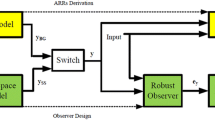Abstract
Model-based fault detection and isolation (FDI) needs an analytical model from which residuals can be obtained from a definite cause and effect relationships. The residuals are considered as the fault indicators, which are utilized for root cause analysis via fault signature and parameter estimation. After the disambiguation of fault, the job remains to take a decision in the supervision platform whether the fault can be accommodated (or tolerated) with the existing instrumentation. This applicability of fault tolerant control (FTC) depends upon actuator sizing through system inversion and control law design. In this work, a proven methodology for FDI using bond graph modeling has been applied to an oil hydraulic test bench for isolating a faulty component. The test bench was designed with a provision to inject a fault. After isolation of the faulty component, estimation of faulty parameters, inversion of systems, actuator sizing, and FTC have been addressed. In this paper, a novel fault tolerant control (FTC) using system inversion with due consideration of actuator constraints is reported. In addition, the receding horizon control as FTC has been corroborated through experimentation in a hydraulic drive, where two-step PI control is used to comply with actuator constraints.
















Similar content being viewed by others
References
Åström K, Albertos P, Blanke M, Isidori A et al (2001) Control of complex systems. Springer, London
Blanke M, Kinnaert M, Lunze J, Staroswiecki M (2003) Diagnosis and fault-tolerant control. Springer, Berlin
Karnopp D, Margolis DL, Rosenberg RC (2006) Systems dynamics, modeling and simulation of mechatronic systems, 2nd edn. Wiley, New York
Mukherjee A, Karmakar R, Samantaray AK (2006) Bond graph in modeling, simulation and fault identification. I. K International, New Delhi
Borutzky W (2010) Bond graph methodology, development and analysis of multidisciplinary dynamic system models. Springer, London. ISBN 978-1-84882-8
Borutzky W (2011) Bond graph modelling of engineering systems, theory, applications and software support. Springer, New York. ISBN 978-1-4419-9367-0
Bouamama BO, Samantaray AK, Staroswiecki M, Dauphin-Tanguy G (2003) Derivation of constraint relations from bond graph models for fault detection and isolation. Proc ICBGM’03 35(2):104–109
Samantaray AK, Medjaher K, Bouamama BO, Staroswiecki M, Dauphin-Tanguy G (2004) Component based modelling of thermo-fluid systems for sensor placement and fault detection. Simulation 80(8):381–398
Bouamama BO, Samantaray AK, Medjaher K, Staroswiecki M, Dauphin-Tanguy G (2005) Model builder using functional and bond graph tools for FDI design. Control Eng Pract 13(7):875–891
Samantaray AK, Medjaher K, Bouamama BO, Staroswiecki M, Dauphin-Tanguy G (2006) Diagnostic bond graphs for online fault detection and isolation. Simul Model Pract Theory 14(3):237–262
Medjaher K, Samantaray AK, Bouamama BO, Staroswiecki M (2006) Supervision of an industrial steam generator. Part II: Online implementation. Control Eng Pract 14(1):85–96
Samantaray AK, Bouamama BO (2008) Model-based process supervision: a bond graph approach. Springer, London
Ghoshal SK, Samanta S (2011) Robust fault diagnosis and prognostics of a hoisting mechanism: a simulation study (ISSN: 0975-5462). Int J Eng Sci Technol 3(2):962–980
Ghoshal SK, Paul S, Samanta S, Tripathi JP (2016) System identification and multi fault isolation for a hydraulic drive with pump loading. Proc Inst Mech Eng Part O J Risk Reliab 230(4):427–440. doi:10.1177/1748006X16655672
Watton J (1989) Fluid power systems. Prentice-Hall, Englewood Cliffs
Dasgupta K, Watton J, Pan S (2006) Open-loop dynamic performance of a servo-valve controlled motor transmission system with pump loading using steady-state characteristics. Mech Mach Theory 41:262–282
Sarkar BK, Das J, Saha R, Mookherjee S, Sanyal D (2013) Approaching servoclass tracking performance by a proportional valve-controlled system. Trans Mechatron IEEE/ASME 18(4):1425–1430
Hippalgaonkar R, Ivantysynova M (2013) A Series-Parallel hydraulic hybrid mini-excavator with displacement controlled actuators. Proceedings of the 13th Scandinavian International Conference on Fluid Power, SICFP2013, Linköping, Sweden, pp 31–42
Samantaray AK, Ghoshal SK, Chakraborty S, Mukherjee A (2005) Improvements to single fault isolation using estimated parameters. Simul Trans Soc Model Simul Int 81(12):827–845
Hirschorn RM (1979) Invertibility of multivariable nonlinear control systems. IEEE Trans Autom Control 24(6):855–865
Manring ND, Luecke GR (1998) Modeling and designing a hydrostatic transmission with a fixed-displacement motor. J Dynam Syst Meas Control 120:45–50
Kugi A, Schlacher K, Aitzetmüller H, Hirmann G (2000) Modeling and simulation of a hydrostatic transmission with variable-displacement pump. Math Comput Simul 53:409–414
Chinniah Y, Burton R, Habibi S (2006) Failure monitoring in a high performance hydrostatic actuation system using the extended Kalman filter. Mechatronics 16:643–653
Mukherjee A, Samantaray AK (2001) System modelling through bond graph objects on SYMBOLS 2000. Proceedings ICBGM’01 ISBN: 1-56555-103-6. Simul Ser 33(1):164–170
Ngwompo RF, Scavarda S, Thomasset D (1996) Inversion of linear time-invariant SISO systems modelled by bond graph. J Franklin Inst 333(2):157–174
Ngwompo RF, Gawthrop PJ (1999) Bond graph-based simulation of non-linear inverse systems using physical performance specifications. J Franklin Inst 336(8):1225–1247
Ngwompo RF, Scavarda S, Thomasset D (2001) Physical model-based inversion in control systems design using bond graph representation—part 1: theory. Proc Inst Mech Eng part I J Syst Control Eng 215:95–103
Ngwompo RF, Scavarda S, Thomasset D (2001) Physical model-based inversion in control systems design using bond graph representation—part 2, applications. Proc Inst Mech Eng Part I J Syst Control Eng 215:105–112
Samantaray AK, Ghoshal SK (2008) Bicausal bond graphs for supervision: From fault detection and isolation to fault accommodation. J Franklin Inst 345:1–28
Ogata K (2010) Modern control engineering, 5th edn. Pearson Education Inc, New Jersey, pp 568–577
Author information
Authors and Affiliations
Corresponding author
Additional information
Technical Editor: Kátia Lucchesi Cavalca Dedini.
Rights and permissions
About this article
Cite this article
Paul, S., Ghoshal, S.K., Samanta, S. et al. Model-based single fault disambiguation and fault tolerant control for a hydraulic drive using receding horizon. J Braz. Soc. Mech. Sci. Eng. 39, 2405–2419 (2017). https://doi.org/10.1007/s40430-017-0754-4
Received:
Accepted:
Published:
Issue Date:
DOI: https://doi.org/10.1007/s40430-017-0754-4




